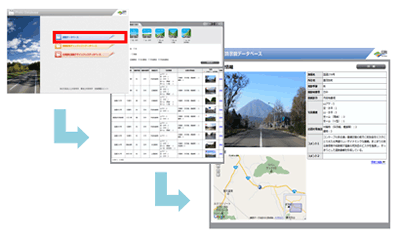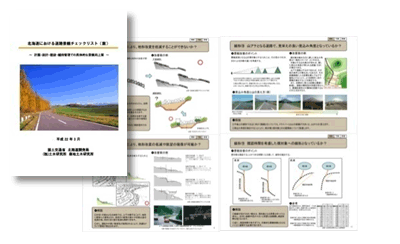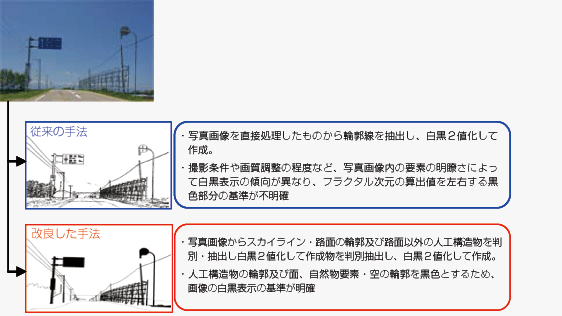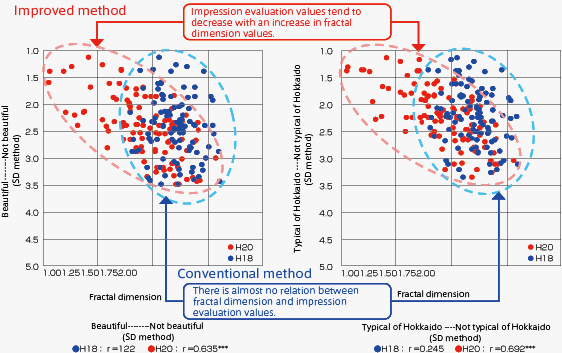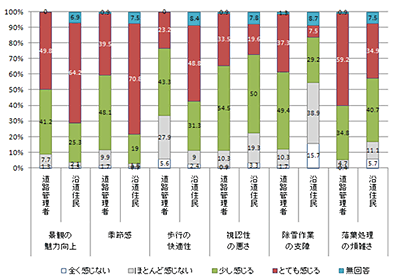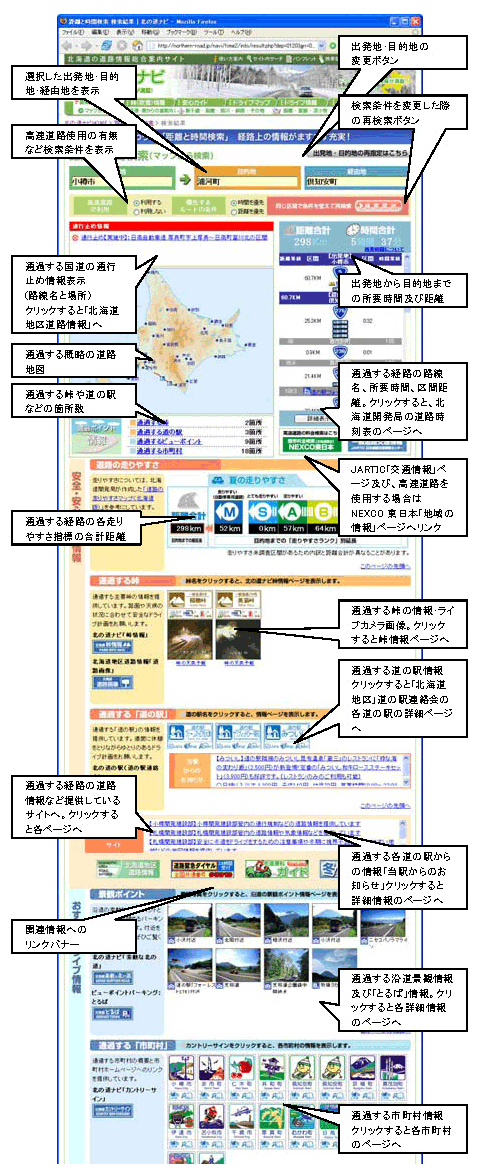|
To contribute to the creation of truly rich social capital and to promote regional development and tourism, we will concentrate on research that is useful for improving the quality of public spaces—spaces that are strongly influenced by the development and improvement of social capital that contributes to increases in the value that derives from the use of such social overhead capital. Studies focus mainly on the creation of attractive landscapes as part of infrastructure development and management, as well as on the use of such landscapes in tourism. Major Research (2016 - 2021) Studies on techniques for "landscape prediction" and evaluation that contribute to efficiency when landscapes in public projects are examined
Since April 2007, based on the Basic Policy for Landscape Examination in Public Works Projects under the Jurisdiction of the Ministry of Land, Infrastructure, Transport and Tourism (MLIT) (Draft) (Basic Policy for Landscape Examination (Draft)), it has become a principle to conduct landscape examination for all projects of the MLIT. To promote and vitalize areas, community development utilizing landscapes has been gaining momentum in recent years. In some public works projects, it is difficult to secure sufficient systems for examining landscapes, such as systems for the establishment of an examination committee. Techniques that can be used by onsite engineers of public work projects for predicting and evaluating landscapes have been called for. Even though the Basic Policy for Landscape Examination (Draft) describes the characteristics and points to consider regarding landscape prediction, it does not specify the prediction methods that are able to be used for various purposes in different types of projects. The Basic Policy for Landscape Examination (Draft) does not describe how to evaluate the results of landscape examination or prediction, either. Such evaluation largely depends on the subjective judgments and empirical knowledge of engineers. There are some problems in consensus-building in such judgment among the engineers. This study aims at the establishment and dissemination of appropriate technologies for predicting and evaluating landscapes—technologies that are able to be used for examining how landscapes should be developed when landscape examination is conducted. Major Research(2016 - 2021) Study on design technologies for roadside rest facilities that are able to be used in various ways
There are 1,059 Michi-no-Ekis (roadside rest areas) nationwide. More than 500 million persons use them. Michi-no-Ekis have become important facilities for regional promotion (as of 2015). The functions desired of these facilities and the use of these facilities are those of regional support facilities. These facilities have functions for providing help and information to non-Japanese tourists, and they serve as shelters at times of disaster. They are used as small-scale bases with social welfare functions. The needs of use and the functions desired by the communities have gradually been increasing and diversifying. However, there are quite a few cases in which planning, design and management methods have not contributed to functional improvements or increased attractiveness for Michi-no-Ekis. Currently, 20 years since the Michi-no-Eki system was launched, the rebuilding and expansion or the renewal of portions of a facility have been increasing; therefore, the need for technical consultation regarding the design of Michi-no-Eki facilities has been increasing. This study aims to help raise the standards for the design, development, and management of Michi-no-Eki facilities by (1) providing appropriate planning, design and management technologies that satisfy certain specified standards and are able to be used for any of the diversifying and evolving functions of Michi-no-Ekis and the similarly diversifying needs of the users, and (2) providing development and management technologies for creating attractive, high-quality Michi-no-Eki facilities that have high utility and are useful and efficient. Major Research(2016 - 2021) Study on techniques for supporting the evaluation, design and management of outdoor public spaces to help develop internationally competitive tourism areas
Making Japan into a nation of tourism is an important agenda of Japan. Under the National Spatial Strategies (National Plan) of August 2015, the development of attractive, world-class tourist areas is said to be required. The Hokkaido Comprehensive Development Plan, Interim Report (Draft) of August 2015 specifies "the development of world-class tourist areas" and, to achieve this goal, "the promotion of technologies that contribute to the promotion of tourism, including the development of favorable landscapes" as major directions to be taken by the national and local governments. In considering how to promote tourism, improve the attractiveness of tourist areas, promote extended stays by tourists, which has been an important issue in recent years, and increase the duration of visitor stays in tourist areas, the following has been identified as important: the quality and functions of landscapes and spaces, including outdoor public spaces (e.g., roads and streets, squares, and the spaces of private properties adjacent to such public spaces). However, not only are Japan's tourist areas inferior to thriving tourist areas overseas in terms of the points described in the previous passage, but Japan's tourist areas have been unsuccessful in improving their quality and functions in many cases. This is because determining and prioritizing those tasks that are truly necessary for the realization of an attractive tourism nation are difficult and because knowledge and technologies necessary for such tasks have not been established. To contribute to the formation of world-class tourist areas in many regions of Japan while keeping in mind that those tourist areas are for those who make long stays at one location, we will clarify the requirements for attractive tourist areas in terms of outdoor public spaces. The knowledge obtained in this study will make it possible to identify problems to be solved regarding outdoor public spaces in tourist areas. We will support the tourist areas in planning for efficient, effective methods for developing and improving outdoor public spaces. Focused Research(2019 - 2021) Studies on proposing diverse, effective technologies for eliminating electric poles in suburban areas and cold, snowy areas
Most of the projects for eliminating electric poles have been done by road administrators. In such projects, underground common ducts for utility lines have been constructed mainly in urbanized and other populated areas. Japan greatly lags other advanced countries in the undergrounding of utility lines. The Interim Report by the Committee for Examining How to Promote Utility Line Undergrounding (August 2017) says that the method using common ducts, which requires considerable time and costs for development, has limitations, and that methods other than the use of common ducts are necessary. In the Revised Plan for the Undergrounding of Utility Lines (April 2018), the MLIT included (1) the elimination of electric poles from roads in order to foster favorable landscapes and promote tourism, (2) the undergrounding of utility lines using diverse development methods under a development system based on appropriate role-sharing by the organizations concerned, and (3) planning for the promotion of utility line undergrounding by local governments. It is estimated that planning and development projects by local governments will be increasing. To support such local governments, know-how in the selection of development methods and in the prioritization of development areas are called for. Once developments in utility line undergrounding have progressed, equipment installed at the ground level will become necessary. Such equipment may affect landscapes and pedestrian traffic. It is also considered that such ground-level equipment may affect snow removal. In some advanced countries, a shift from high-voltage power pylons, which affect roadside landscapes, to underground facilities has been promoted. It can be assumed that a shift from high-voltage power pylons to underground facilities will be called for in Japan, too. This study proposes diverse methods for utility line undergrounding that are suitable for individual roadside environments and proposes appropriate role-sharing methods between road and utility administrators. We will conduct this study with the purpose of improving the way ground-level equipment affects the landscape.
All of these studies are for landscape improvements that relate to infrastructure, the creation of attractive communities, and the utilization of improved landscapes. Basic Studies (2019 - 2021) Studies on roadside greening that contributes to landscape improvements in cold, snowy areas
The greening of roads has various functions, including cityscape improvement and the preservation of favorable living environments. In recent years, the importance of street trees has been recognized in terms of creating attractive cityscapes and promoting community development. Trees, which are important landmarks and are essential landscape elements, have been preserved and taken care of. Species of street trees planted in cold areas are those that tolerate severe cold climates. In road and community greening, it is considered important to select tree species that suit the region's characteristics. In studying street trees, it is necessary to conduct research based on the knowledge of which tree species suit each region, including studies on native species. Orderers and contractors of street tree maintenance do not have sufficient numbers of professional engineers and experienced tree care professionals; therefore, there are some cases in which inappropriate pruning is done on street trees because of a technical decline in personnel. Under severe government financial conditions, the development and maintenance of road greenery require efficient, effective work execution and labor savings. The pruning of street trees currently done in cold, snowy areas may be considered excessive. To remedy this, it is necessary for both the orderers and the contractors of street tree maintenance to take appropriate financial measures, secure and educate personnel, and conduct maintenance based on quantitative indexes. This study proposes management for road greening trees and greenbelt zones on roads in cold, snowy areas.
Basic Studies(2017 - 2020) Studies on color design for civil engineering facilities
In public spaces, the colors and landscapes of civil engineering facilities can greatly affect their functions. Each type of civil engineering facility has certain desirable colors. The subjects of examination for suitable colors are not limited to the facility under planning, but include enormous numbers of existing civil engineering facilities. Examination of suitable colors is strongly required for any existing facility that is repaired, rebuilt, or expanded. However, there are no specified methods for color design for civil engineering facilities in public spaces. Civil engineers have difficulty in selecting colors for facilities. Therefore, there are not a few cases in which inappropriate color selection has not only harmed the landscape but has decreased the performance of the civil engineering facilities. In cold, snowy areas, the landscape greatly changes in the snowy season; therefore, consideration for winter landscape is also necessary. Furthermore, cost reduction has been an important issue in developing civil engineering facilities in recent years. Careful examination of painting costs is also required. In this study, by conducting (1) and (2) below, we aim to propose rational color design methods that consider costs and the changes in landscape in the snowy season.
Past research projects Emphasis Study (H23-26) A study on optimum layout technology for road space elements by means of multidimensional evaluation including landscape functions
Consideration of landscapes is required for public projects conducted by the Ministry of Land, Infrastructure, Transport and Tourism (MLIT), and technologies to meet these requirements are becoming necessary. The national government is also promoting the establishment of a tourism-oriented country as the New Growth Strategy. Since tourism is one of Hokkaido's key industries and the number of both Japanese and overseas tourists who enjoy driving and the roadside landscapes is increasing, the prefecture is expected to contribute to the growth strategies of both the national government and MLIT.
Meanwhile, investment capability for road improvement is decreasing with an increase in maintenance and renewal costs due to financial shortages, and an increase in and aging of infrastructure stock in recent years. Therefore, it is necessary to establish efficient road improvement, maintenance and control technologies that can ensure the necessary functions while at the same time being landscape friendly.
In this study, an evaluation technology for sequence landscapes of roads will first be developed through clarification of the evaluation structure for such landscapes. Next, multidimensional evaluation will be conducted on the landscape and other functions, and the costs of the elements of road spaces currently designed and established in accordance with various establishment criteria, for the purpose of optimizing road spaces including their landscapes.
An example of aesthetic layout of roadside landscape and road space elements (snow poles that are not disturbing the landscape) >>Open in a new browser window >>Clsoe Emphasis Study (H23-26) A study on design technologies for pedestrian spaces using spatial recognition
In recent years, street spaces and station squares of cities have been improved for tourist promotion and revitalization of downtown areas. However, in many past cases, improvements have not contributed effectively to the creation of actual activities, due to insufficient consideration to users' impression assessment and improvements in comfort levels in terms of improving the attractiveness of pedestrian spaces.
Accordingly, it is necessary to develop evaluation methods and design technologies for pedestrian spaces that can contribute to improvements in the attractiveness of tourist spots and downtown areas, based on the relationship with users' special recognition, impression assessment, walking behavior and other factors.
Against the above backdrop, this study aims to present evaluation methods and design technologies for attractive pedestrian spaces through field observation, comparative experiments and verification of users' spatial recognition and walking behavior.
The results are expected to help create pedestrian spaces that can contribute to regional promotion, in the form of technical data for identification of specific problems and appropriate design support in improvement of pedestrian spaces. >>Open in a new browser window >>Close Emphasis Study (H18-22) A Study on the Creation of Beautiful and Pleasant Roadside Environments in Hokkaido
Tourism is a key industry in Hokkaido. Many domestic and overseas tourists visit the island for its beautiful landscape and other features. In particular, the number of self-drive tourists from overseas is increasing rapidly. Social needs for improvements in roadside landscapes are also increasing with the full-scale implementation of the Scenic Byway Hokkaido scheme. Therefore, this study focuses on the landscapes (internal landscapes) of roads that serve as main transport routes and important viewpoints, and presents road scenery evaluation methods and improvement measures, as well as highway landscaping methods that can contribute to landscape and environmental improvement. We aim to contribute to the improvement of roadside landscapes in cold, snowy areas through these studies.
Landscape improvement measures There are many suburbs in Hokkaido where natural and rural landscapes of world-class beauty can be enjoyed while driving on roads. However, snow-protection and various other roadside facilities also exist to ensure safe and smooth traffic and maintenance/management of roads, blocking the view of beautiful landscapes that extend behind them. Against such a background, this study presents specific landscape improvement measures that can lead to cost reductions, easier maintenance/management and landscape conservation, for the purpose of effective improvement in road landscapes in cold, snowy regions. Such measures include "landscape creation by subtracting," which aims to reduce facilities while maintaining necessary road functions. These achievements have been used as the basis for development of the Road Landscape Database and Road Landscape Checklist in Hokkaido (draft).
Roadside facilities that block Hokkaido's beautiful background landscapes (right)
Road Landscape Database
Road Landscape Checklist in Hokkaido (draft))
Landscape evaluation With the recent increase in landscape improvement efforts in public works projects, road landscape evaluation is becoming increasingly necessary, and the necessity of consensus building based on discussions with relevant parties is also increasing. However, since no road landscape evaluation methods have been established and there are no unified guidelines or standards, difficulties are encountered in landscape examination and consensus building. If a road landscape evaluation method can be used as a guideline that reflects subjective personal feelings to a certain degree, it can be an effective tool to facilitate landscape examination and consensus building. Therefore, this study aims to present a road landscape evaluation method that can be applied as a tool for landscape examination and consensus building.
An example of a road landscape evaluation method (combination of personal impression and quantitative evaluation) Applicability was improved by reflecting the impression evaluation by the SD method and improving the image recognition method in fractal analysis.
Improvement of the image recognition method
Comparison of results
Roadside tree planting Roadside trees, slope vegetation and other roadside greenery greatly affect roadside landscapes and environments. However, highway landscaping involves a variety of problems, such as securing of planting sites and selection of tree types. There are especially many problems concerning maintenance/management, which is required for many years after planting. Whether the effect of planting can be fully displayed or not depends on the quality of maintenance/management. However, due to recent attempts to reduce maintenance costs, excessive pruning is conducted in some areas to reduce the frequency of which underbrush clearing and tree trimming takes place, resulting in the reduced function of roadside greenery. Cold, snowy regions also have regional problems, such as poor growth and slow progress of natural succession due to severe weather conditions and damage caused by mechanized snow removal. Against the backdrop of the establishment of the three laws on scenery and greenery, and increasing social demands, this study aims to present a highway landscaping method that can also contribute to the landscape, environment and reduction of maintenance costs.
Effects and influences of roadside trees
Over-pruned roadside trees Left: The naturally shaped tree on the right is pruned gradually like the one on the left, resulting in loss of leafy shade in summer. Right: Due to excessive pruning to avoid power lines, there are never any green leaves, even in June. >>Open in a new browser window >>Close Basic Studies(2015 - 2019) Studies on the use of wood in civil engineering
In recent years, the necessity of contributing to environmental preservation and promoting the local economy by using local wood has been urged. The use of wood is also called for in civil engineering. Revitalization of the forestry industry has been required for the appropriate maintenance and management of forests (artificial forests). To encourage and support efforts to address such needs, the expansion of the use of wood has been an urgent task. In 2010, the Public Buildings Wood Use Promotion Act was enacted, and it specifies that necessary measures should be taken in civil engineering to promote the construction of wooden structures. However, the strength and quality of wood are not consistent, and the lack of durability of wood from rotting is a problem. In light of Japanese society's need to reduce costs and labor regarding the development and maintenance of social overhead capital, the dissemination of wood as a construction material has not progressed in the way that planners had envisaged. Under such circumstances, the Japan Society of Civil Engineers, the Japan Forest Society, and the Japan Wood Research Society, jointly published a proposal titled "Toward the Expansion of Wood Use in Civil Engineering" in March 2013. This proposal has five items, including "Development and promotion of technologies for wood use" and "Development of design methods and listing of the developed methods in related standards." These organizations have been calling for cooperation from government agencies and other organizations, including educational institutions. This study clarified many of the benefits and points to bear in mind when using wood as a civil engineering material. These are the value and usefulness of using wood; methods for evaluating the durability of wood, which are necessary for installing wooden structures; and maintenance and management techniques required for wooden structures. The study aims to present the types of structures and the range within some structures for which local wood is applicable, and the standards for decision-making by the orderers in using wood in civil engineering structures. Base Study (H22-26) A Study on the Social Effects of Landscapes in Hokkaido
With the recent establishment of the three laws on scenery and greenery and Basic Act for Promoting a Tourism-Oriented Country, infrastructural development is required to contribute to landscape improvement, regional revitalization and promotion of the tourist industry. Meanwhile, due to the current difficulty in investment into public works projects, it is becoming increasingly necessary to disclose the results and other details of individual projects. Against such a background, this study aims to clarify the social effects of good landscapes in Hokkaido and other rural areas in a systematic manner, by identifying the influences and effects of good landscapes and landscape improvement measures on local communities, and setting guidelines on the improvement in value and ripple effects that can be achieved by individual landscape formation. These results are expected to contribute to the support for consensus building in landscape projects and urban development. >>Open in a new browser window >>Close Base Study (H23-25) A study on the effects of power lines and utility poles on landscapes, and effective landscape improvement measures in suburban areas
Social needs for improvements in roadside landscapes are increasing due to the establishment of the Basic Act for Promoting a Tourism-Oriented Country (2008), as well as high expectations on regional revitalization through promotion of tourism, and the positioning of attracting overseas tourists as a new growth strategy of the national government.
Roadside landscapes, on which regional impressions depend significantly, are affected greatly by roadside power lines and utility poles that are installed in large numbers. They have an especially strong influence on diminishing regional appeal, especially in Hokkaido, where beautiful landscapes provide the background for many roads.
Roadside utility poles cause many other problems, such as hindrance to traffic safety and maintenance/management. While conversion to underground power lines and other measures have been taken in urban areas, almost no landscape measures involving power lines and utility poles have been taken in suburban areas.
However, it is considered highly likely that studies of landscape measures involving suburban power lines and utility poles will contribute to the solution of these problems, since there are many other landscape improvement methods in suburban areas besides underground power lines, and it is possible for local governments to take independent measures using subsidies for public works.
Therefore, a study on effective methods of minimizing the hindrance to landscapes by power lines and utility poles in suburban areas of Hokkaido will be promoted by sorting/systematizing the current problems and presenting landscape improvement methods that are considered effective, based on field surveys and analysis of influences on landscapes. >>Open in a new browser window >>Close Base Study (H23-25) A study on easy-to-understand information and guidance systems and design of public spaces
Regional revitalization through the establishment of a tourism-oriented country under the New Growth Strategy of the national government and creation of internationally competitive tourist spots under the new Comprehensive Development Plan of Hokkaido are among the main policy objectives. Much "urban development" activity through tourism has recently been observed in Hokkaido and other parts of Japan, in expectation of regional revitalization.
The number of Japanese and overseas tourists using rented cars is increasing. The increase in the number of overseas tourists that drive has been especially significant in recent years, and a further increase is expected in the future. The number of elderly drivers is also increasing yearly. Therefore, it is necessary to introduce universal information and guidance systems that are easy for non-Japanese and elderly people to understand, and such systems are also expected to contribute to the creation of attractive tourist spots.
However, since the current criteria for information and guidance systems were established many years ago and are not sufficient to deal with the current increase and diversification of tourist traffic, independent measures concerning such systems are being taken in some regions. Meanwhile, there are also cases in which the use of too many signs results in an actual reduction in the effect of such information, or causes hindrance to landscapes in tourist spots, and these problems have been pointed out by Ministry of Land, Infrastructure, Transport and Tourism committees.
Since guidance by information signs alone has its limitations, it is necessary to develop easy-to-understand space design in which spatial structures and other facilities supplement each other.
Therefore, this study includes sorting/systematization of problems concerning information and guidance systems mainly from the viewpoint of users of tourism-related traffic, consideration of effective landscape-friendly systems, surveys on understandability of spaces and presentation of effective information and guidance methods in combination with space design. >>Open in a new browser window >>Close Base Study (H18-22) A Study on Advanced Use of Road-Related Information in Hokkaido
Many self-drive tourists are visiting Hokkaido, and in particular, the number of such tourists from overseas is increasing. However, tourists from outside of Hokkaido tend to plan unreasonable itineraries as they are unfamiliar with the local geography, lack a sense of distance and have insufficient information on local conditions, such as snowfalls on mountain passes in spring and autumn, and the supply of information to support their driving plans is necessary from the viewpoint of traffic safety. Meanwhile, since winter snowstorms cause road closures and multiple collisions in Hokkaido, it is also necessary to provide information to ensure the safety and comfort of road users under severe weather conditions. Against such a background, this study combines official road information with regional information in a sophisticated manner to present a method of supplying information depending on the situations and user needs in all seasons.
Proposal of an effective method of supplying information that works in conjunction with the route information service >>Open in a new browser window >>Close Base Study (H21-22) A Study on the Creation of Touring Environments from the Viewpoint of International Road Tourism
In Hokkaido, the number of overseas tourists that drive rented cars has increased dramatically in recent years, and this tendency is expected to continue in the future. Realization of an attractive driving environment for overseas tourists will lead to higher international competitiveness of Hokkaido's tourism industry and contribute to the promotion of regional tourism. Some tourism-oriented countries are active in promoting road tourism for overseas tourists. Therefore, from the viewpoint of promoting road tourism for overseas tourists in Hokkaido and the rest of Japan, a study on the creation of universal and attractive touring environments is to be conducted to realize internationally competitive self-drive tourism. Since there are many aged drivers in rural areas of Hokkaido due to insufficient public transport, this study will also be important for senior citizens faced with similar barriers.
>>Open in a new browser window >>Close Base Study (H21-23) A Study on Improvement of Attractiveness of Roadside Rest Facilities and Parking Spaces
In Hokkaido, where tourism is a key industry, the number of tourists driving rented cars is increasing yearly. In particular, the number of such overseas tourists has increased dramatically, making this area of tourism internationally competitive. Since traveling distances are long in Hokkaido, roadside stations are particularly important as roadside rest areas, and it is also known from past studies that such roadside stations have significant influence on the satisfaction levels of self-drive tourism. However, since current emphasis is on the sale of goods and supply of food and drinks, the response to the needs of rest areas is insufficient. Against such a background, this study presents specific measures to improve the attractiveness of roadside stations as rest areas, through fact-finding surveys and interviews with users, while developing a method of establishing attractive roadside parking facilities.
Pleasant rest area >>Open in a new browser window >>Close Base Study (H22-24) A Study on Footpaths Using Regional Resources
In Hokkaido, the development of footpaths has recently been promoted, mainly by local residents. Since the New Hokkaido Comprehensive Development Plan also states "promotion of development of footpaths and other facilities making use of the most charm of Hokkaido's natural environment" as one of its strategic targets, the utilization of infrastructural spaces is expected to contribute greatly to future footpath development. Against such a background, this study clarifies the social effects of footpath development and discusses the reduction of traffic barriers in road and river improvement/management, and the improvement in attractiveness of spaces to achieve more effective utilization of infrastructural spaces.
>>Open in a new browser window >>Close
|


